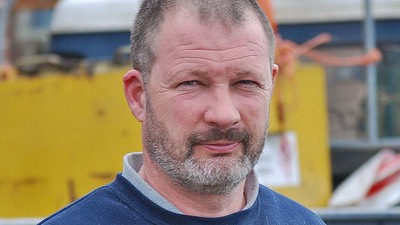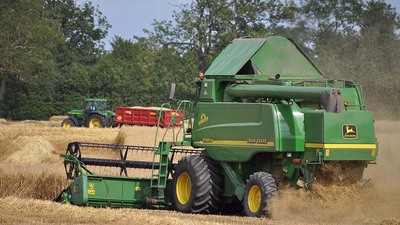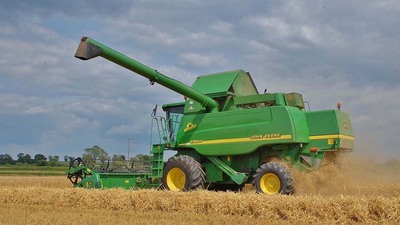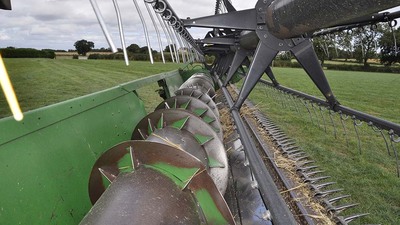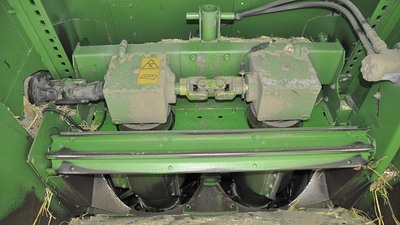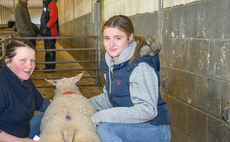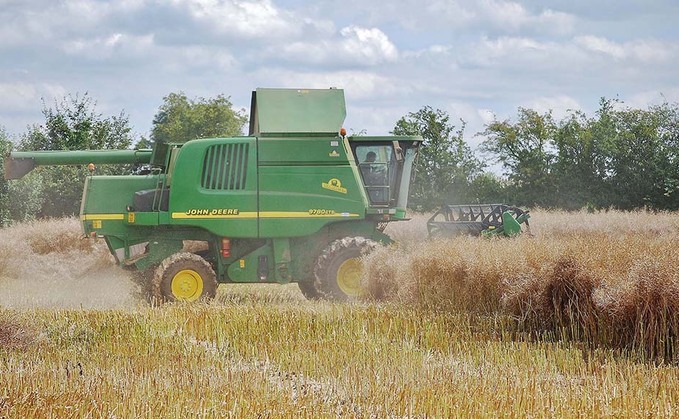
For one Warwickshire farmer a John Deere 9780 CTS combine provides affordable harvesting capacity. As it enters its sixteenth season on the same farm, Simon Henley finds out some of the benefits and the pitfalls of using a 20-year-old combine harvester.
The John Deere cylinder tine separator (CTS) was heralded as the worlds first hybrid combine when it was launched in 1992. Equipped with a conventional threshing drum and a twin-rotor separation system instead of straw walkers, the CTS made its UK debut in 1998.
In 2001 it was superseded by the 9780 CTS model, which was manufactured at Zweibrucken in Germany. While the new model shared many of its predecessors key features, the 9780 CTS boasted more power (310hp), automatic header floating, a larger 10,000-litre grain tank, a larger fuel tank and introduced self-supporting moulded composite side panels.
Natural Progression
Warwickshire farmer and contractor Colin Fisher purchased his John Deere 9780 CTS Hillmaster in October 2005 to replace a 1999 CTS model. The price of the four-year-old 9780 CTS equipped with a 7.6-metre header, was 75,000. An allowance of 32,000 was given as the trade-in value of the outgoing CTS model, leaving a balance of 43,000 to complete the deal.
Mr Fisher says: Our John Deere 9780 is a very early production example.
It features the original CTS grain tank lids which opened from the sides of the tank. Another giveaway is the emblem on the back of the combine. Ours still has the old-style leaping deer trademark, which John Deere discontinued in 2000.
The 9780 CTS is essentially like a five straw walker combine, with six straw walker output. For a combine of this capacity it has a narrow track width so it is easy to move around and will fit down most roads.
Mr Fishers combine averages about 365 hectares per season, currently harvesting oats, barley, wheat and beans. In the past it has also been used it for harvesting ryegrass, linseed and oilseed rape.
Overshot Beater
According to Mr Fisher, the 9780 CTS is at its happiest in wheat, where it will comfortably harvest 35 tonnes per hour. It also performs well in oats, but provides little advantage over a straw walker machine in barley where its output drops to 30t/hour.
A weak link in the design of this combine is the John Deere 925 header, which has very little operating adjustment," says Mr Fisher.
"One of the key issues, is you can not adjust the table length. This means in crops like OSR and beans, pre-combine losses can escalate because there is not enough table area between the knife and the intake auger to prevent the seeds from shattered pods falling on the ground.
The CTS will work in most conditions, but there are two crop conditions this combine does not like. The first is very brittle crops, which will break-up inside the combine and will not pass through the rotors.
The second is green or damp crops, which cannot always be avoided, but without deliberately slowing down you will increase the risk of blocking the rotors. If the rotors start blocking up, you will see the gearstick vibrating.
He adds. The Achilles heel of the CTS combines is the overshot beater shaft. This shaft can be easily bent if the combine is blocked up. A bent shaft causes severe vibration, which you will feel in the drivers seat. This in turn can cause gearbox and/or structural damage, and may also cause damage to the main countershaft.
Another potential problem when harvesting crops like beans or linseed, is debris wrapping around the front rotor bearings. When this happens, the bearings will start to overheat, which can potentially cause a fire. It is just something else you need to be aware of.
The straw chopper on the 9780 CTS is a belt-driven unit, which is manually engaged at the rear of the combine. Typically, Mr Fisher will swath most of the wheat, barley and oat straw he harvests, so the straw chopper has only been re-knifed once since he has owned the combine.
Unless the straw is very brittle, straw quality in the swath is never an issue, says Mr Fisher.
This John Deere does not chew up the straw like some rotary combines, and in most conditions it will throw a neat and even swath. Unless the straw quality itself is poor, you can bale conventional, round or big-squares without a problem.
Hill Master
Arguably one of the most impressive features available on the 9780 CTS, was the optional HillMaster full-body levelling system. This allows the combine to maintain a level cleaning area, on slopes or across hill sides of up to 22 degrees.
With a skilful operator at the controls, the HillMaster system also enables the combine to be manually tilted. This can prove to be very useful when negotiating tight gateways with the header still attached, or adjusting the height of the unloading auger while topping-off a grain trailer.
Mr Fisher says: The hillside levelling compensator ram is located underneath the combine behind the front axle.
If it has been damaged or broken, it will prevent the combine from sitting level and will need to be professionally welded to repair it. Touch wood we have not had a problem with our combine, but I know other farmers who have.
By the end of the 2021 season, the 9780 CTS will have harvested more than 8,000ha since it left the factory.
That is an estimated 75,000t of grain and seed crops, which have passed through the unloading auger.
Naturally, like any machine, the 9780 CTS has its good and bad points, but Mr Fisher explains how he keeps his 20-year-old combine in reliable working condition.
The answer is regular care and maintenance," he says.
"The combine is blown off at the end of each day with a leaf blower to remove any excess chaff. Obviously we grease up everyday and perform service checks or make any required repairs.
I have been caught in the rain, but this combine has never been left outside in the rain overnight since I have owned it. Every year it is serviced and given a thorough pre-season inspection by John Deere combine specialist Pete Hunt. Once it has been serviced, it is then washed and polished with a polymer wax before we start combining. This encourages dust and chaff to fall away from the paint, and helps keep the combine clean.
I spend an average of 3,000 a year in service and upkeep costs, adds Mr Fisher.
If there is a breakdown, then the costs will increase. All combines break down, but that is certainly a risk you take running an older machine.
At the end of the day, this combine owes me nothing.
It has cut 6,000ha since we have owned it and it is still earning its keep. For the acreage we are farming today, buying a new combine or even one that is five years old, just does not stack-up financially. For the time being, I think we will stick with the John Deere 9780 CTS.
